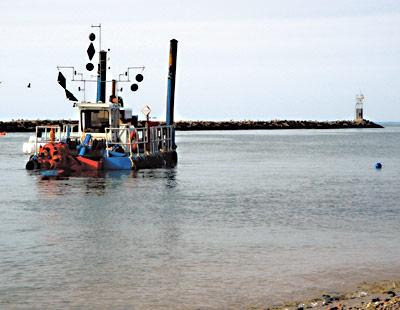Problems Seen in Montauk Dredging

During the first week of an emergency dredging of the Montauk Harbor Inlet, a number of boats struck the 12-inch diameter pipe that transports sand from the dredge on the east side of the inlet to the beach on the west side of the harbormouth. At least one vessel was damaged.
During the same period, the buoys marking the channel that boats are meant to use during the dredging were not lighted properly at night. At times, fishermen returning to the harbor were told to wait outside the inlet for upward of an hour, or they were unable to contact dredging contractors on the specified V.H.F. frequency for instructions.
East Hampton Town Supervisor Bill Wilkinson convened an emergency meeting of fishermen with the contractor, North American Landscaping, Construction, and Dredge Company, and the contractor’s Army Corps “quality assurance” overseer, Jeff Ice, at the Montauk Coast Guard station on Monday afternoon. Army Corps headquarters in New York City attended the meeting via conference call.
Montauk Coast Guard’s senior chief petty officer, Jason Walter, said the station had been monitoring the confusion as well as informing the contractor that both their buoy configuration and lighting were not meeting navigation standards.
“The pipe was impossible to see during the storm,” Mr. Walter said, referring to the gale that blew through on Saturday. Mr. Walter also noted that the pipe had been rising off the bottom, apparently because it was not properly anchored, and was endangering Coast Guard boats as well.
Captain Rick Etzel said the propeller of his boat was damaged when it struck the pipe, and his boat drew only three feet of water. Dragger captains, whose vessels draw up to 12 feet when returning to the harbor with fish, said it was imperative that they knew the pipe was safely on the bottom well before they made the turn into the inlet. It was impossible for bigger boats to turn around once they entered, said Capt. Vinny Carillo.
“These are federal codes,” Ed Michels, the town’s senior harbormaster, told the contractor.
“How many warnings do there have to be before the dredge project itself becomes a hazard?” asked Bonnie Brady, executive director of the Long Island Commercial Fishing Association.
According to the contractor’s representativessentatives, fixing the physical problem appeared straightforward. But fishermen said they were not satisfied that the communication problem was being addressed. The Army Corps New York office suggested boat captains communicate with the contractor directly to learn the status of the pipeline when entering, or to voice other problems.
“No,” Mr. Wilkinson said emphatically. “I want a central source for complaints.” He suggested that source be the Army Corps representative on the scene. Mr. Walter said his office would monitor the needed corrections and take complaints, which would then be passed along to the Army Corps New York office.
Yesterday morning Mr. Ice, the Corps on-site overseer, said that the contractor was well along on the needed corrections.
“The sunken line is set,” he said, and in the process of being anchored. The “floating line” — the section of pipeline that runs from the dredge itself to the point where it is submerged to the bottom — had been marked with yellow flashing lights, as prescribed. The two points at which the pipeline descends to the bottom, and, after snaking its path across the channel, comes back to the surface, have been marked with the appropriate red flashing lights, Mr. Ice said. He added that an Army Corps representative would be on station through the nighttime hours.
“The Coast Guard has been a great help monitoring boat traffic while we have been setting things back up, a really big help,” Mr. Ice said.
“Bill Wilkinson did a good thing getting the people together,” Ms. Brady said yesterday, “but why did the meeting have to be held? This was completely on the Army Corps shoulders.”
